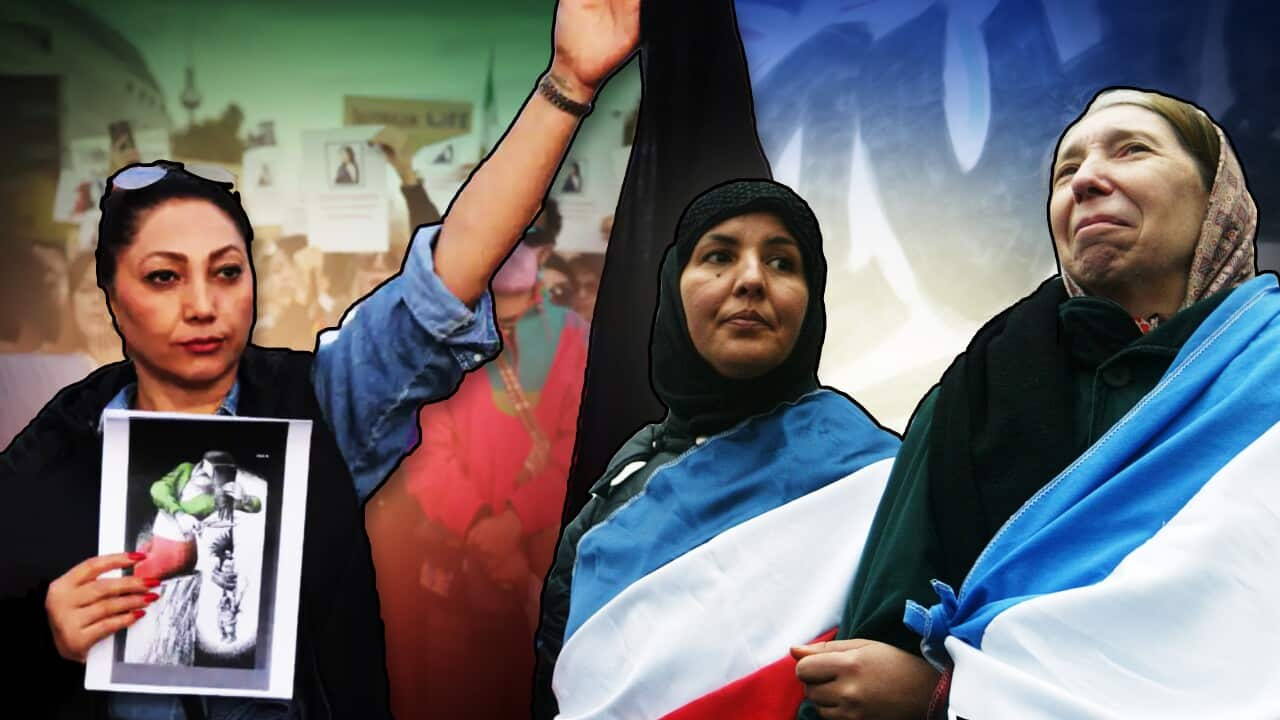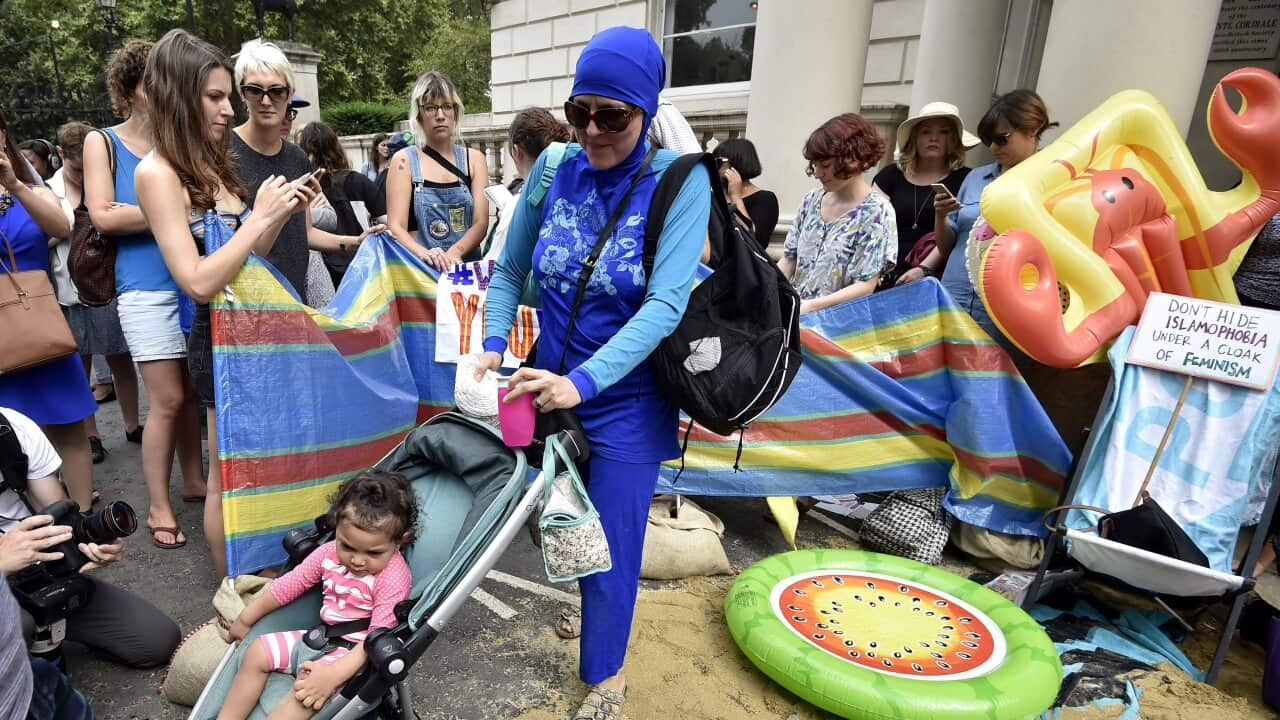Key Points
- The wearing of the Islamic headscarf, or hijab, is being politicised in different countries around the world.
- What are the actual religious rules about wearing the hijab?
Thousands of women in Iran are rising up against their government .
In cities all around Iran, they are burning the hijabs they are forced to wear.
Protests have also spread to Australian cities. In Canberra on Tuesday, dozens gathered on the lawns of Parliament House, chanting "women, rights, freedom!", and holding banners with the words "Freedom of choice!".
The hijab - or headscarf - is often perceived as a highly-politicised symbol and is now at the centre of a revolt against hard-line Iranian officials.
Tensions exploded on 16 September, when Ms Amini, also known as Jina, fell into a coma and died after she was arrested by Iran's morality police for allegedly wearing her hijab inappropriately.
Frustrated with the conservative government's rules, scores of women are risking their lives in defiance against officials, burning their headscarves and chopping their hair off on the streets.

Women are chopping off their hair around the world in solidarity with Iranian women who are protesting against the government following the death of Mahsa Amini. Source: AAP / ANP / Sipa USA
So what exactly are the Islamic rules around wearing the headscarf, and why are governments making decisions about how Muslim women can dress?
What does Islam say about the hijab?
Islamic Studies researcher and lecturer at Charles Sturt University, Derya Iner, said a hijab - which means "cover" in Arabic - is generally understood to be a headscarf.
Muslim women wear the hijab in accordance with the widely accepted interpretation of two verses from their holy text, the Quran.
According to Dr Iner, these verses have been read by many scholars to highlight that Muslim women should cover their hair, neck, and ears while wearing long, loosely-fitted clothing in a show of modesty.

Four Muslim women wearing their hijabs walk through Jakarta. The way in which Muslim women wear their hijab differs, depending on their cultural dress. Source: Getty / Goh Chai Hin
But Muslims believe a hijab is more than just a headscarf. It also encompasses the modest social conduct in which Muslims, both men and women, are expected to carry themselves in public. This includes their behaviour, manners and speech.
Why do Muslim women wear the hijab?
Dr Iner explained that the "simplest explanation" for wearing the hijab is that her religion has told her to do so, to display her show of worship explicitly.
"I'm trying to follow the guidelines given to me by my religion to perform how to be modest and this is my choice," Dr Iner said.

Muslim students protested against the headscarf ban at Brussels university college. Source: Getty / NurPhoto
"More broadly and particularly when it's a religious minority, it's a symbol of belonging to that community," Dr Hussein said.
Do Muslim women have to wear the hijab?
While some Muslim women wear the hijab, there are others who don't, but still identify as Muslim.
Some have worn it for years, but changed their minds in later years - and vice versa.
Dr Hussein said scholars differ on their interpretation of whether it's compulsory, and the extent to which they need to cover themselves.
But the hijab is widely viewed as a religious requirement that must be done of the woman's own volition. Women can choose to wear it at any point in their lives when they feel ready to commit to the hijab.
"According to that interpretation, it's an obligation that one voluntarily undertakes. You can regard it as an obligation, but it's up to you whether to do it or not," Dr Hussein said.
"There are some women who do believe that it is a religious obligation, but have for whatever reason chosen not to wear it."
She explained reasons could include - but are not limited to - fear of harassment, Islamophobia and barriers to seeking employment.
"There are others who don't believe it's religiously obligatory but choose to wear it out of solidarity for other Muslim women as a statement of belonging to their religious community or as a stance against Islamophobia."
Can women be forced to wear the hijab?
According to Dr Iner, Islam forbids acts of worship under compulsion. So, Muslim women cannot be forced to wear the hijab but must do so using their "own, free will".
"Human beings are left alone to make their own choices. And if you are doing it not for the sake of God but for the sake of ... your [country's political] regime, that can be problematic," she said.
She said from an Islamic perspective, performing an act of worship without having the willed intention can invoke a sense of duality or hypocrisy, which is frowned upon in Islam.
"That is not the divine view ... That is obviously diluting the main concept of being a servant to God."
So why are women forced to wear it in Iran?
Prior to the 1979 revolution, Iran was being transformed into a secular state.
In 1936, wearing the hijab was banned in Iran by then-ruler Reza Shah Pahlavi. A decade earlier in Turkey, the same move was enforced. Dr Hussein said that women who unveiled were seen as a "symbol of modernity".

Iranian women walk down a street in the capital Tehran, wearing their hijabs loosely around their faces. Muslim women style their hijabs in different ways, depending on personal and cultural factors. Source: Getty / AFP / Atta Kenare
When the revolution took shape in 1979, Iran's supreme leader Ayatollah Ruhollah Khomeini enforced the hijab mandate to establish the "Islamic Republic".
From unveiling by force to veiling by force, Dr Iner said that women's visibility was used as a political tool to fuel their "so-called Islamist regime".
"It is a regime, just using Islam in their words. It doesn't necessarily make Islam responsible for what they do," Dr Iner said.
"Women burning the hijab, they don't do it to protest a verse from the Quran. They are doing it show their frustration, controlling of bodies, but overall the regime and how they're treating minorities."
"It's part of a wider context of imposing that form of religiosity on a society, and also, of course, patriarchy and control of women," Dr Hussein added.
Do Muslim women have the choice to wear the hijab in other parts of the world?
While in Iran, women are fighting to remove their hijabs, Muslim women in India are facing a significant court battle to uphold their right to wear their scarves at school.
In Karnataka, Muslim girls have taken their appeals to the Supreme Court after a ban on wearing religious garments was banned at educational institutions in February this year.
Since the ban was imposed to bolster uniformity, protests erupted around the country as many hijab-wearing Muslims - who believe the hijab is a religious requirement - feel like they must compromise their faith or their right to education.
In France, wearing the headscarf and "other religious symbols" is banned in all state schools, as well as for public servants. In 2010, it became the first European country to enforce a nationwide ban on the face-covering burqa in public areas, such as parks, public transport and open streets.
Women in France caught wearing the burqa in public face a 150-euro fine or a requirement for citizenship classes.
It is all about controlling the bodies of women, but also trying to show the regime and the pillars of their government by instrumentalising women's visibility.Dr Derya Iner
In Iran, the penalty for not wearing the hijab is a prison sentence, a fine or flogging.
Other laws have also been voted on around France, like banning the hijab for lawyers in court, in sporting competitions and for mothers from participating in extracurricular school activities.
The "burkini" - long clothing to swim at the beach often worn by hijab-clad women - is also banned on several beaches in the country's south.
These laws were put in place by the French government in a "fight against separatism and attacks on citizenship" and to further establish a secular society.
Dr Iner said that women in Iran, France and India are facing the same struggle: "the authority is trying to control our bodies".

A woman supports her right to wear a hijab at a candlelight march to protest against a hijab ban in Karnataka's educational institutions in India. Source: Getty / Pacific Press
"To be (hijabi) or not be (hijabi) is the business of no state or man. Solidarity with women resisting patriarchal control, the world over," activist and author, Yassmin Abdel-Magied, wrote on Twitter.
Indian activist Tara Krishnaswamy described women in both countries fighting for their rights as courageous.
"In Iran, women removing the Hijab is courageous. In India, women wearing the Hijab is courageous. It isn't contradiction; it is standing up to patriarchal hegemony & an oppressive state in both cases," Ms Krishnaswamy said.










